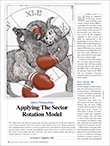 Editor,
Editor,Just finished reading the 30-year highlights article (“A 30-Year Lookback,” October 2012). Wow!
LETTERS TO THE EDITOR
The editors of S&C invite readers to submit their opinions and information on subjects relating to technical analysis and this magazine. This column is our means of communication with our readers. Is there something you would like to know more (or less) about? Tell us about it. Without a source of new ideas and subjects coming from our readers, this magazine would not exist.
Address your correspondence to: Editor, Stocks & Commodities, 4757 California Ave. SW, Seattle, WA 98116-4499, or E-mail to editor@traders.com. All letters become the property of Technical Analysis, Inc. Letter-writers must include their full name and address for verification. Letters may be edited for length or clarity. The opinions expressed in this column do not necessarily represent those of the magazine. —Editor
Editor,
Congratulations on your 30th anniversary. I’ve enjoyed the entire ride with you, as I have every issue. Here’s to another 30.
Greg Morris
Chairman, Investment Committee
Chief Technical Analyst
Stadion Money Management
Greg Morris has contributed many articles to S&C over the years, including “Candlesticks And Stochastics” (August 1991), “Developing a Trading System” (March 1996), “East Meets West: CandlePower Charting” (December 1990), “Breadth Of Fresh Air” (December 2005), and our interview with him, “The Danger Zone With Gregory Morris” (September 2009).—Editor
 Editor,
Editor,
Just finished reading the 30-year highlights article (“A 30-Year Lookback,” October 2012). Wow!
On page 4, there’s a statement that QQQ became QQQQ and that it is tradable.
I believe this to be in error. QQQ still tracks the NASD 100 and QQQQ is not tradable. QQQQ (also QQV) is the volatility index now.
Rudy Teseo
Thank you for correcting this point.
Rudy Teseo is a longtime contributor to this magazine and to our online publication, Working-Money.com. Past articles of his include “The Butterfly Setup” (S&C, April 2001); “Candlestick Filtering” (S&C, December 1999); “Those Ubiquitous Fibonacci Ratios” (Working-Money.com, March 2002).—Editor
 Editor,
Editor,
As a longtime reader of S&C going back to the early 1990s, I just wanted to provide some feedback on what I feel is typical of a useless article, with all respect for its author. Apart from filling pages in the magazine, I fail to see any practical trading relevance or usefulness in “Applying The Sector Rotation Model” (August 2012).
I am not against sector rotation, which for a long time has proven to be useful. But this article is on the SRMind indicator. Even in the time span in the examples shown in Figure 3 of the article, I can see almost as many examples when both the SPX and SRMind together fall below or rise above their threshold (respectively, the 200-period moving average and the zero level), but nevertheless prove to give false signals. So following this strategy would probably generate much poorer results than simply spreading the best sector ETF with the weakest one, meaning buying the highest sector rate of change and selling the weakest. Thus, I don’t see the need for an article here.
Just my two cents. What I like to see as a trader and an investor is systems and strategies backed by rules and results.
Carl Vanhaesendonck
Belgium
Author Giorgos Siligardos replies:
Thank you for your feedback, which not only gives me the opportunity to support the usefulness of my article but also allows me to point out that automatic system-biased readers often miscomprehend articles addressing discretionary investors.
Let me start by saying that the article was not only about the SRMind, since more than three pages were dedicated to the theory and logic of the sector rotation model (SRM) as well as the merits and drawbacks of three ways to use it in investing. Thus, even if the SRMind were of no use, the article could still serve as a short yet comprehensive summary of the SRM for the uninitiated. Note that the SRM is not just about trading strong/weak sectors in a trend-following fashion. The SRM is a model (a paradigm) with roots in macroeconomic logic.
The SRMind (at least as presented in my article) is an analysis tool. It is neither a system in and of itself, nor part of a system. It is a numerical way to isolate the backbone of the SRM and monitor the shifts of money from market expansion-related sectors to market-contraction ones and vice versa, so that conclusions about the intention of the stock market (as shown by macro investors’ attitudes) can be extrapolated. These shifts are not manifested the same way in bull and bear markets and the SRMind contributes to the publicly available bibliography by quantitatively discriminating them (see Figure 2 of the article). You could do your own research on how to incorporate the SRMind in a very long-term algorithmic investing strategy, but as shown in the examples, this will not be a simple task.
With respect to the “false signals” of the strategy you mention, I must emphasize that even though the zero line is indeed a threshold for the SRMind, I clearly stated in the interpretation section of the article that, “An applicable interpretation of the SRMind, however, is more sophisticated.” I then elaborated extensively on how to use this indicator to complement long-term classic technical analysis, and I never stated that the zero threshold could be simply used along with moving average crossovers to provide a trading system. In fact, my final sentence of the article was, “Utilize this indicator in your long-term stock market analysis with due diligence according to the guidelines mentioned, and don’t blindly use it to obtain simple buy/sell signals because that is not why it was created.” Honestly, I don’t know how I could make that clearer.
It is not forbidden for the readers to construct and/or evaluate systems based on the ideas presented in S&C; it is just that an article’s usefulness should not be ranked based on the poor results that such a system may produce, especially when the author explicitly declares that he does not endorse them.
Based on your final comment (and your comments about the profit/loss of a crossover strategy), I conclude that your feedback was motivated by disappointment because of the absence of an explicit trading system utilizing the model. S&C has published an abundance of articles on systems and strategies. My article simply does not fall in this category, since it addresses mainly the discretionary traders/analysts and it is, I believe, harsh to say it is of no use just because it doesn’t provide an automatic trading system. At the very least, it gives ideas for further research on the quantitative manifestation of the SRM.